The IRF 2025 Top Performer Study: Automotive & Manufacturing Industries
by Incentive Research Foundation
How Leading Companies More Effectively Leverage Non-Cash Rewards & Recognition Strategies
Introduction
In the Spring of 2025, the Incentive Research Foundation relaunched its Top Performers study to answer a fundamental guiding question in motivation and engagement: What do high-performing companies do differently with their reward and recognition programs? Drawing from a comprehensive survey of program decision-makers within the automotive and manufacturing industries, this study segment aims to provide insight into proven methods to help address recent challenges in workforce retention, labor shortages, and shifting employee expectations. By examining how leading companies strategically design, deliver, and manage their reward and recognition programs, this study uncovers actionable insights that can guide organizations seeking to boost engagement, reinforce culture, and drive business performance in today’s rapidly evolving automotive and manufacturing landscape.
This research reflects the growing importance of non-cash rewards and recognition as essential levers for motivation and engagement. Although reward and recognition programs cannot be definitively credited with causing high performance, top-performing companies consistently leverage these tools to resonate personally with employees and partners, reinforce business objectives, and foster long-term commitment. The exploration of such methods lays the foundation for successful program design to be replicated by other organizations hoping to achieve similar results.
Research Methodology & Respondent Profile
The comprehensive study included 600 participants, 149 of whom are full-time employees with significant influence over incentive reward and recognition programs at companies generating at least $100 million in annual revenue in the automotive and manufacturing industries. The vast majority of these organizations were large, with 93% employing 500 or more people. Within the automotive industry, a targeted focus was applied: 68% of automotive respondents represented original equipment manufacturers (OEMs), 15% were with aftermarket parts dealers, and 18% came from retail-focused businesses.
Respondents also detailed the types of reward and recognition programs active within their organizations. Employee incentive programs were the most common, reported by 96% of respondents. Sales reward and recognition programs were included by 83%, and 51% reported programs addressing channel partners.
While the scope of the project reflected a broad representation of the incentive industry, its primary purpose was to examine what differentiated top-performing companies from others. A defined set of criteria including revenue growth, achievement of performance goals, customer trends and employee or partner attraction and retention was used to establish the standard that set high-achieving organizations apart. Top Performers were identified as those that:
- Achieved revenue growth over the past year
- Met or exceeded the majority of their performance goals
- Maintained or expanded their total customer base over the past year
- Highly successful in acquiring new customers
- Retained most customers year-over-year
- Maintained or increased their number of employees over the past year
- Consistently attracted high-performing professionals
- Hold a strong reputation as an employer of choice for top talent
Companies that did not meet this full set of performance indicators were categorized as Comparators. This segmentation provided a practical and data-driven lens for analyzing the reward and recognition practices that aligned with stronger business outcomes. Among all respondents in the automotive and manufacturing industries, 24% qualified as Top Performers, while 76% were designated as Comparators.
Key Areas of Differentiation
Top Performers Leverage Executive Support
High-performing organizations set their programs up for success by securing strong executive sponsorship from the outset. Nearly 80% of Top Performers rate executive support for their reward and recognition programs as excellent, more than 20 percentage points higher than the Comparator group. This senior-level backing provides the visibility and prioritization needed to position reward strategies as a core business function. With leadership invested, these companies are better equipped to develop programs cohesively. In fact, 89% of Top Performers report that their programs are designed and managed with strong cross-departmental collaboration, compared to 65% of Comparators, a dynamic often driven by engaged leadership.
Top Performers also benefit from stronger program resourcing. 75% rate their staffing support as excellent, compared to just 47% of Comparators. Similarly, 61% of Top Performers give their program funding top marks, while only 41% of Comparators do the same. Together, executive advocacy, solid staffing, and sufficient budgets enable Top Performers to execute their programs more effectively and with greater long-term impact.
Top Performers Diversify Reward Offerings
High-achieving companies stand out by offering a more diverse mix of reward options designed to meet a wide range of participant preferences. Nearly all Top Performers leverage incentive travel, gift cards, and award points in their reward and recognition programs, and most also include merchandise. While both groups typically offer multiple forms of non-cash rewards, Comparators are less likely to include incentive travel, award points, and merchandise. This broader variety reflects a stronger commitment to relevance, choice, and participant engagement.
Top Performers Prioritize Flexibility and Creating Memorable Experiences
Top-tier companies approach incentive program design with a strong emphasis on participant flexibility and perceived reward value. They are more likely than Comparators to prioritize rewards that allow choice and cater to individual preferences, with 57% highlighting flexibility as a top priority for incentive travel and 74% for non-travel awards, compared to just 28% and 38% of Comparators. Similarly, 59% of Top Performers rate high perceived value as critical for merchandise and gift card rewards, well above the 38% reported by Comparators. This focus ensures rewards feel personally meaningful and motivating, helping to drive deeper engagement and stronger emotional connections.
Where Top Performers clearly differentiate themselves is in how they tailor rewards to participant desires rather than simply offering broad, generic options. While both groups value unique experiences, Top Performers place greater weight on perspective, with 43% prioritizing participant preference in travel rewards compared to 17% of Comparators. This participant-centric approach enables Top Performers to deliver more relevant and impactful reward experiences that stand out in efforts to engage and motivate personnel.
Top Performers Tailor Program Features to Maximize Motivation and Engagement
Top Performers emphasize structuring programs to engage all participants. Particularly within sales and employee reward programs, high-achieving companies are 25-30% more likely to use incremental targets for creating clear, achievable steps that encourage steady progress and motivate participants by celebrating incremental wins instead of waiting for a single end goal. Additionally, nearly all Top Performers incorporate “Fast Start” incentives that reward early achievements, giving participants immediate momentum and boosting initial engagement. They are also more likely than Comparators to offer programs with unlimited rewards (90% versus 63%), encouraging sustained effort and fostering a culture of ongoing high performance. This approach reflects a mindset shift. Where fixed-budget programs may be seen as a cost, unlimited rewards signal confidence in the program’s ability to drive results and fund itself through improved performance. These elements contribute to increased motivation at all levels of achievement within the organization.
Top Performers Emphasize Reward Value
While successful companies take different approaches in reward program inclusion and exclusion, there is no clear difference between Top Performers and Comparators in how frequently they provide reward and recognition to program participants. However, higher-achieving companies distinguish themselves through significantly greater reward values, especially for their top talent.
For non-travel incentives, Top Performers invest substantially more across sales, channel, and employee programs. For example, the average non-travel reward value for top employees at Top Performer companies is more than double that of the Comparator group. Top Performers also offer sales incentive travel rewards valued on average over $2,000 higher. This increased investment reflects more than just higher spending, it reflects a strategic approach to recognition. Top Performers understand that reward value strongly influences motivation and engagement. By offering rewards that feel personal, prestigious, and proportional to achievement, they foster stronger behavioral reinforcement. This strategic emphasis on quality and relevance helps drive sustained high performance and deeper participant commitment over time.
Summary
The findings from the 2025 Top Performers Study indicate that leading automotive and manufacturing companies do more than just run reward and recognition programs. They craft strategic incentives that drive motivation and are closely tied to business success. These organizations prioritize strong executive sponsorship and cross-functional collaboration to ensure their programs have the visibility, resources, and cohesion needed to deliver real impact.
Top performing companies distinguish themselves through deliberate design choices. They offer a broad and diverse range of rewards tailored to participant preferences, with a strong focus on flexibility, meaningful experiences, and high perceived value. Their programs are structured to drive early momentum and maintain sustained effort by using milestone-based goals, “Fast Start” incentives, and uncapped rewards to keep participants motivated across all achievement levels.
Importantly, these companies thoughtfully invest in reward value. They do not simply increase spending – they elevate quality and relevance to deepen emotional connections and reinforce desired behaviors. By providing recognition that feels personal, prestigious, and proportional to achievement, Top Performers foster long-term commitment and a culture of high performance.
For organizations looking to improve their reward and recognition efforts, the key is to take an intentional design approach. Embed programs within the fabric of the business, secure active leadership support, foster collaboration, and design flexible, participant-centric rewards that deliver an exceptional experience. When implemented well, these reward and recognition programs become more than incentives; they become integral drivers of culture, engagement, and sustained success.


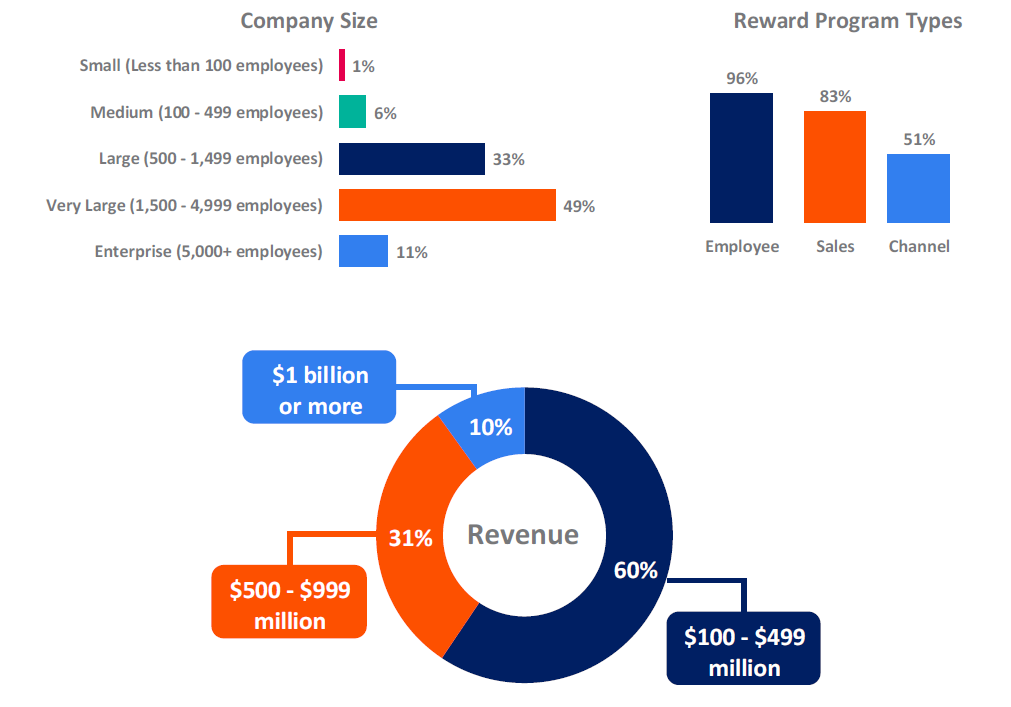
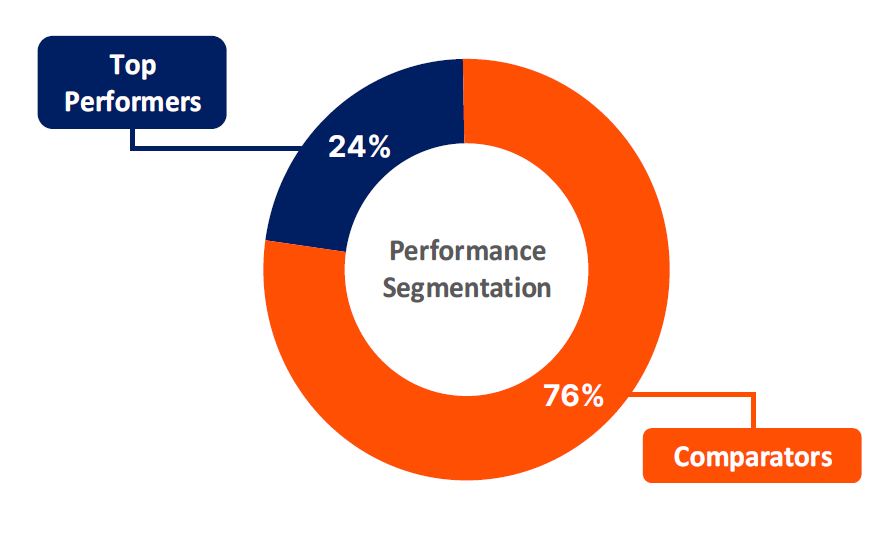
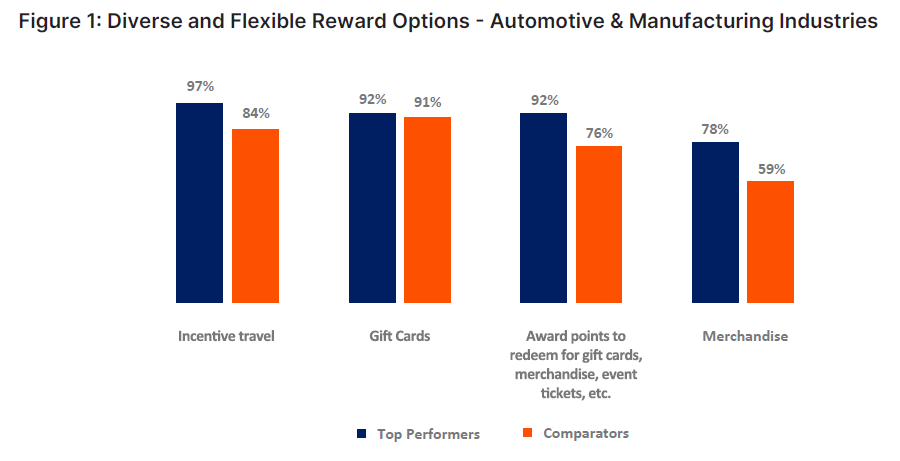
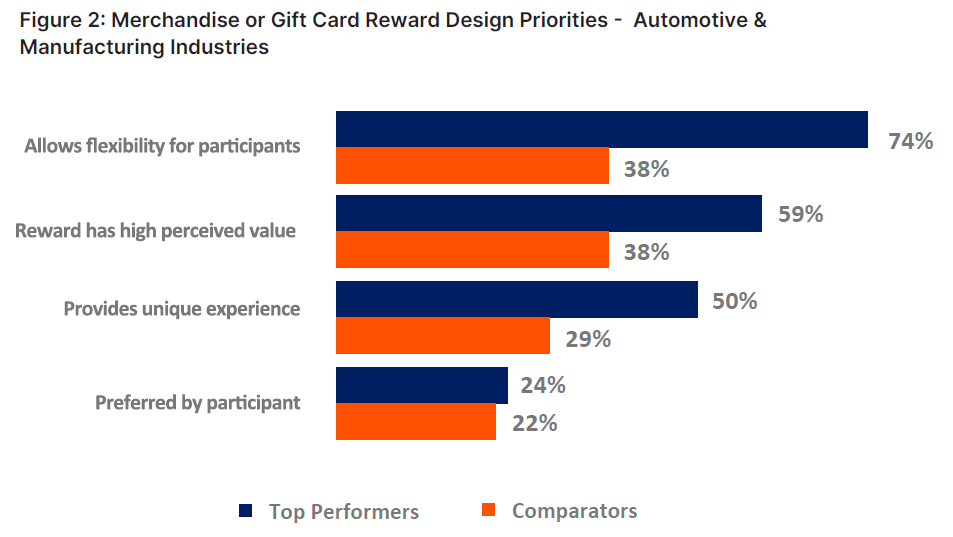
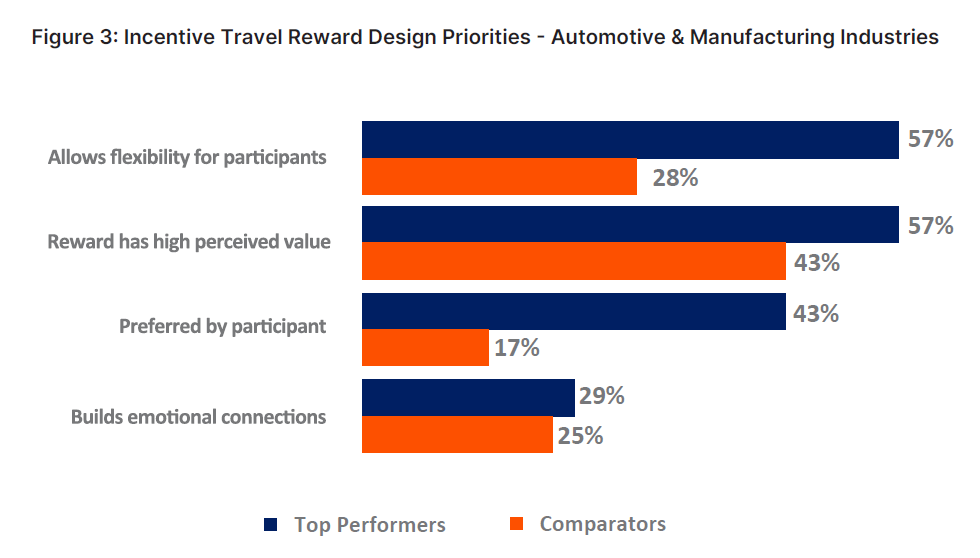
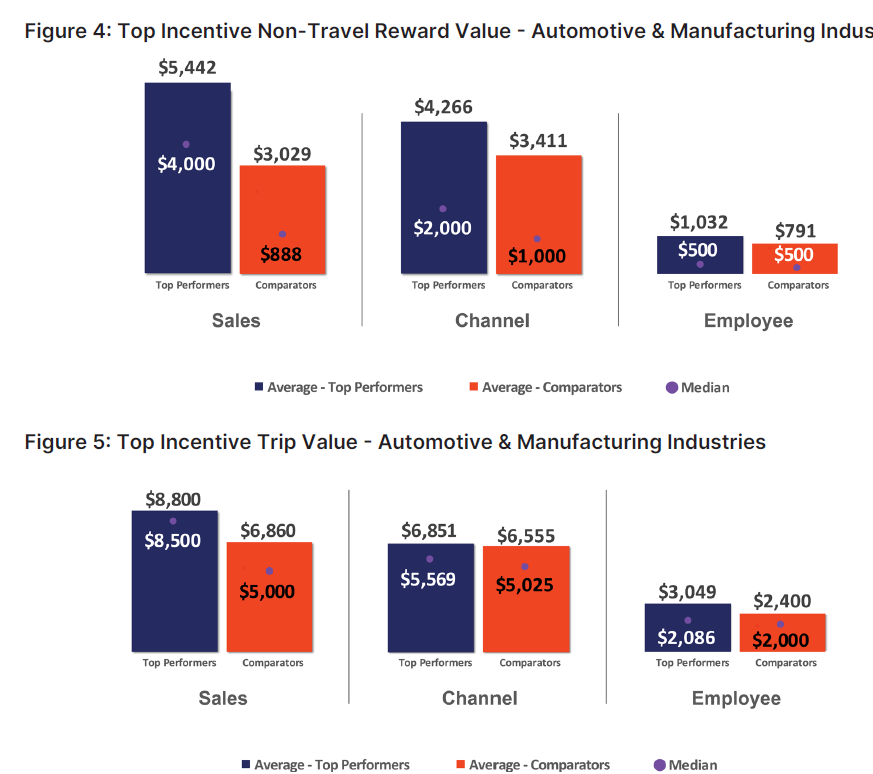
Comments are closed